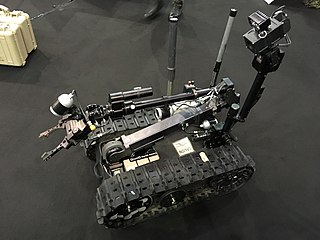
Interoperability is a characteristic of a product or system to work with other products or systems. While the term was initially defined for information technology or systems engineering services to allow for information exchange, a broader definition takes into account social, political, and organizational factors that impact system-to-system performance.

The Defense Information Systems Agency (DISA), known as the Defense Communications Agency (DCA) until 1991, is a United States Department of Defense (DoD) combat support agency composed of military, federal civilians, and contractors. DISA provides information technology (IT) and communications support to the President, Vice President, Secretary of Defense, the military services, the combatant commands, and any individual or system contributing to the defense of the United States.
In NATO, a standardization agreement defines processes, procedures, terms, and conditions for common military or technical procedures or equipment between the member countries of the alliance. Each NATO state ratifies a STANAG and implements it within its own military. The purpose is to provide common operational and administrative procedures and logistics, so one member nation's military may use the stores and support of another member's military. STANAGs also form the basis for technical interoperability between a wide variety of communication and information systems (CIS) essential for NATO and Allied operations. The Allied Data Publication 34 (ADatP-34) NATO Interoperability Standards and Profiles which is covered by STANAG 5524, maintains a catalogue of relevant information and communication technology standards.

The Department of Defense Architecture Framework (DoDAF) is an architecture framework for the United States Department of Defense (DoD) that provides visualization infrastructure for specific stakeholders concerns through viewpoints organized by various views. These views are artifacts for visualizing, understanding, and assimilating the broad scope and complexities of an architecture description through tabular, structural, behavioral, ontological, pictorial, temporal, graphical, probabilistic, or alternative conceptual means. The current release is DoDAF 2.02.
The NATO Consultation, Command and Control Agency (NC3A) was formed in 1996 by merging the SHAPE Technical Centre (STC) in The Hague, Netherlands; and the NATO Communications and Information Systems Agency (NACISA) in Brussels, Belgium. NC3A was part of the NATO Consultation, Command and Control Organization (NC3O) and reported to the NATO Consultation, Command and Control Board (NC3B). In July 2012, NC3A was merged into the NATO Communications and Information Agency (NCIA).
The international standard IEC 61499, addressing the topic of function blocks for industrial process measurement and control systems, was initially published by the International Electrotechnical Commission (IEC) in 2005. The specification of IEC 61499 defines a generic model for distributed control systems and is based on the IEC 61131 standard. The concepts of IEC 61499 are also explained by Lewis and Zoitl as well as Vyatkin.
The British Ministry of Defence Architecture Framework (MODAF) was an architecture framework which defined a standardised way of conducting enterprise architecture, originally developed by the UK Ministry of Defence. It has since been replaced with the NATO Architecture Framework.
The Combined Communications-Electronics Board (CCEB) is a five-nation joint military communications-electronics (C-E) organisation whose mission is the coordination of any military C-E matter that is referred to it by a member nation. The member nations of the CCEB are Australia, Canada, New Zealand, the United Kingdom, and the United States. The CCEB is the Sponsoring Authority for all Allied Communications Publications (ACPs). ACPs are raised and issued under common agreement between the member nations. The CCEB Board consists of a senior Command, Control, Communications and Computer (C4) representative from each of the member nations.
The IDEAS Group is the International Defence Enterprise Architecture Specification for exchange Group. The deliverable of the project is a data exchange format for military Enterprise Architectures. The scope is four nation and covers MODAF (UK), DoDAF (US), DNDAF (Canada) and the Australian Defence Architecture Framework (AUSDAF). The initial scope for exchange is the architectural data required to support coalition operations planning, including:
JC3IEDM, or Joint Consultation, Command and Control Information Exchange Data Model is a model that, when implemented, aims to enable the interoperability of systems and projects required to share Command and Control (C2) information. JC3IEDM is an evolution of the C2IEDM standard that includes joint operational concepts, just as the Land Command and Control Information Exchange Data Model (LC2IEDM) was extended to become C2IEDM. The program is managed by the Multilateral Interoperability Programme (MIP).
IEC 60870 part 6 in electrical engineering and power system automation, is one of the IEC 60870 set of standards which define systems used for telecontrol in electrical engineering and power system automation applications. The IEC Technical Committee 57 have developed part 6 to provide a communication profile for sending basic telecontrol messages between two systems which is compatible with ISO standards and ITU-T recommendations.
The Combined Federated Battle Laboratories Network (CFBLNet) is a laboratory environment which utilizes a distributed Wide Area Network (WAN) as the vehicle to simulate training environments and to de-risk command and control (C2) and intelligence capabilities by conducting Research and Development, Training, Trials and Assessment (RDTT&A) on command, control, communication, computer, intelligence, surveillance and reconnaissance (C4ISR) initiatives and training events. Since 2001, membership has been established and represented by three core parties: the U.S. Joint Staff, the Combined Communications and Electronics Board, and the North Atlantic Treaty Organization. Besides the core parties to the CFBLNet Technical Arrangement, three nations have become Guest Mission Partners under rules contained in CFBLNet governance documentation referred to as Publication 1.
The Open Group Future Airborne Capability Environment was formed in 2010 to define an open avionics environment for all military airborne platform types. Today, it is a real-time software-focused professional group made up of industry suppliers, customers, academia, and users. The FACE approach is a government-industry software standard and business strategy for acquisition of affordable software systems that promotes innovation and rapid integration of portable capabilities across programs. The FACE Consortium provides a vendor-neutral forum for industry and government to work together to develop and consolidate the open standards, best practices, guidance documents, and business strategy necessary to result in:
The Joint Theater Level Simulation (JTLS) is used to simulate joint, combined, and coalition civil-military operations at the operational level. Used for civil/military simulations and humanitarian assistance/disaster relief (HA/DR) scenarios, JTLS is an interactive, computer-assisted simulation that models multi-sided air, ground, and naval resources with logistical Special Operation Forces (SOF) and intelligence support. The primary purpose of JTLS is to create a realistic environment in which agency staff can operate as they would within a real-world or operational situation. A training audience conducts a scenario or event to practice their ability to coordinate various staff functions.

Saber Strike is an annual international exercise held since 2010 by the United States Army Europe (USAREUR) focused on the Baltic States. The exercise spans multiple locations in Lithuania, Latvia and Estonia and involves approximately 2,000 troops from 14 countries.

The Joint Deployable Analysis Team (JDAT) is part of the J6 Directorate of the Joint Chiefs of Staff.

UGV Interoperability Profile (UGV IOP), Robotics and Autonomous Systems – Ground IOP (RAS-G IOP) or simply IOP was originally an initiative started by the United States Department of Defense (DoD) to organize and maintain open architecture interoperability standards for Unmanned Ground Vehicles (UGV). A primary goal of this initiative is to leverage existing and emerging standards within the Unmanned Vehicle (UxV) community such as the Society of Automotive Engineers (SAE) AS-4 Joint Architecture for Unmanned Systems (JAUS) standard and the Army Unmanned Aircraft Systems (UAS) Project Office IOPs.

Federated Mission Networking (FMN) is a significant initiative to help ensure interoperability and operational effectiveness of the North Atlantic Treaty Organization, it is a key contribution to the Connected Forces Initiative, helping Allied and Partner forces to better communicate, train and operate together. This includes the NATO Command Structure as well as the NATO Force Structure. The purpose of FMN is ultimately to support Command, Control, Communications, Computers, Intelligence, Surveillance and Reconnaissance (C4ISR) and decision-making in operations by enabling a rapid instantiation of mission networks. Including the NATO Command Structure, 37 nations have joined the FMN initiative as so called "FMN Affiliates" and work together under the FMN Framework Process to coordinate the design, development and delivery of operational and technical capabilities required to conduct net-centric operations. Each development increment is referred to as an "FMN Spiral". The respective requirements, architecture, standards, procedural and technical instructions are documented in so called "FMN Spiral Specifications". FMN Spiral Specifications are based on well known standards and best practices, hence supported by most off-the-shelf products and vendor neutral. TACOMS standards and profiles specify a common, technology and topology independent network interoperability layer for federated mission networks. There is also a rolling 10-year FMN Spiral Specification Roadmap of the envisioned future capabilities. At the same time, the Coalition Interoperability Assurance and Validation (CIAV) process ensures that current interoperability issues are being identified and fed back into FMN capability development.

This article outlines the defence forces of the European Union (EU), which implement the EU's Common Security and Defence Policy (CSDP) in CSDP missions. There are two categories of EU multinational forces: ones that have been established intergovernmentally and made available to the CSDP through article 42.3 of the Treaty on European Union (TEU), such as the Eurocorps; and the EU Battlegroups, established at the EU level.

The NATO Science and Technology Organization (STO) is the primary NATO organization for Defence Science and Technology. Its stated intent is to maintain NATO's scientific and technological advantage by generating, sharing and utilizing advanced scientific knowledge, technological developments and innovation to support the alliance's core tasks.









